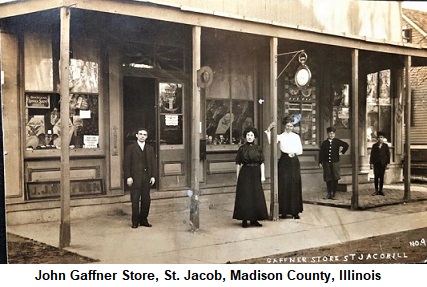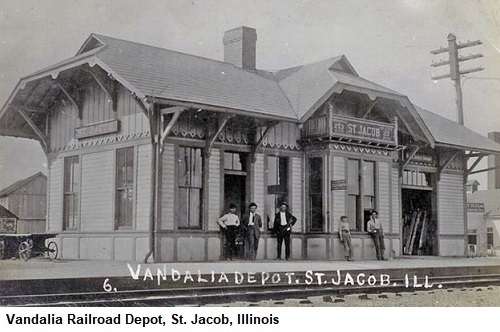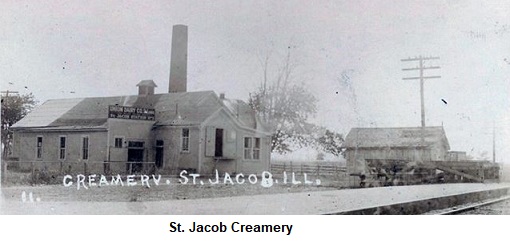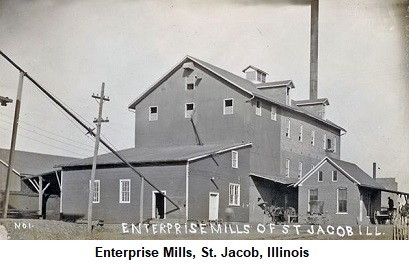Early History of St. Jacob
Looking Glass Prairie
The natural state of the prairie in St. Jacob Township was a
beautiful tract of country. It looked more like a beautiful park
than a wild country. It was not like many other prairies, a
monotonous level where the eye can find no resting place, but was
covered with luxuriant grass and flowers of all colors, with
beautiful hills, many of which were covered with fine trees. Small
streams, frequently embellished with fine willows, crossed the
prairie in all directions. The east fork of Silver Creek was the
principal stream. A number of small groves were made up of trees
such as linden, oak, hickory, buckeye and locust.
Early Settlers
The first house in the future village of St. Jacob was built at a
crossroads by Jacob Schutz, where he sold whisky by the gallon. In
1849, Jacob Schroth opened a store. He purchased two and a half
acres on the corner of Jacob Schutz’s farm and erected a small
house, which he later enlarged. This building was called St. Jacob’s
House. There he entertained travelers, and also had a wagon yard in
connection with his saloon and store. In June 1851, Schroth got a
post office established, and since his name was Jacob, and Jacob was
the original owner of the land, and the blacksmith’s name was Jacob,
they concluded to name the place St. Jacob. Mr. Schroth continued in
business here until his death in 1860. His wife was then
commissioned postmistress, and continued the business many years. In
1850, Jacob Willi opened a blacksmith shop. After several years, he
moved to a farm half a mile north of town. The third house in St.
Jacob was constructed by Louis Schiele. It later became the Pfaelzer
Hof.
Founding of St. Jacob
In 1866, Mr. Schiele laid out the town of St. Jacobs [the "s" on the
end was later dropped]. The town was formally organized as a village
on November 02, 1875. The first board was composed of G. W. Hays,
president; Louis Schiele, clerk; John Schaefer, treasurer; and
Christopher Moore, Jacob Schrodt and Melchior Fischer as members.
The Railroad
The village grew principally around the Schroth corner and on the
St. Louis wagon road, until the construction of the St. Louis,
Vandalia & Terre Haute Railroad. Since that time, the growth was
primarily toward the depot. St. Jacob became an important shipping
point for farmers there and in Marine, five miles away. There were
about twenty houses in St. Jacob before the railroad was
constructed. The census of 1880 gave it a population of four hundred
and sixty-one. Dr. Buck was the first physician.
Progress
In 1866, Edward Dee and William C. M’Alilly built a sawmill a
quarter of a mile north of town. They afterward put up a small grist
mill, and took into partnership with them Charles Valier, who was a
practical miller. The mill
A sawmill near the depot was erected in 1880, and was owned by John
Bartle. The Independent Bucket Factory was opened in June 1881 by
John Schaefer, employing six to eight men.
A village hall was constructed sometime in the 1800s, at the corner
of Third and Douglas Streets. It was demolished in December 2017,
and a new village hall constructed in its place.
St. Jacob Businesses in 1882
Physicians – B. F. Stephens, E. Miller, and H. R. Kirsten
Postmaster – G. W. Hays
Hotels – Henry Laengle – Laengle’s Hotel; Louis Wasem - Pfaelzer
Hof; Henry Schmitt – St. Jacob’s House; Ernst Pahmeyer – Rail Road
Hotel
General Stores – G. W. Searcy, Karges & Williams, F. Sohler
Lumberyard, Lime, Cement – E. N. Peterson
Hardware & Farming Implements – John Schaefer
Grain Dealer – Anderson & Wiseman
Drugstore – Charles Spies, H. F. Wood
Furniture and Undertaker – H. A. Reichenbecher
Harnes and Saddles – Theodore Schmidt, Fred Pfunder
Meat Market – Louis Schiele; J. Freys
Merchant Tailor – F. Gain
Blacksmith Shops – Fred Spies, Joseph Beckler, Leonz Buehlmann
Wagon Shops – Leonz Buehlmann, Henry Maurer
Wagon Maker – Fritz Graf
Bakery – H. Meyer
Barbers – Melch Hochul, Thomas Cannon
Shoemakers – Joseph Hilbi, C. M. Petry
Cigar Manufactory – W. Fisher
Early St. Jacob Schools
The first settlers of St. Jacob Township gathered together within
the walls of an old fort in 1812-13, for safety against the Indians.
There they maintained a school taught by David Smeltzer. As soon as
peace had settled over the countryside, in 1817 they erected a cabin
between the homes of Parkinson and Anderson, for school purposes.
When this cabin was abandoned, a new schoolhouse of logs was
erected. In 1828, a new schoolhouse was constructed near the Uzzle
Spring in 1828, and classes were first taught there by Alexander
Trusedale. In the same neighborhood, a school was taught, prior to
this, by Mr. Edmonds, in an abandoned cabin that stood near Dugger’s
ox mill. John Kile was among the pioneer teachers of St. Jacob
Township. By 1882, there were six schools in St. Jacob Township –
three of whom were in the village of St. Jacob under the
superintendence of J. W. Wells, a teacher. The two-story brick
schoolhouse in St. Jacob (1882) consisted of four rooms, where three
teachers were employed.
Early St. Jacob Churches
The Pleasant Ridge Baptist Church was erected near St. Jacob in
1844, with 25 members. Members included J. Lindly, W. M. Lindly, and
T. Steele. Pastor of the church before 1883 were Joseph Lemen, M.
Ely, C. J. Kelly, H. Thompson, J. B. White, J. H. Mize, W. D. Ross,
and H. S. Deppe.
By 1882 there were two churches – the Lutheran (a brick structure
built in 1869), and the Methodist (a frame building built in 1879).
The Lutheran Church was destroyed by a tornado in 1905, and rebuilt
the same year. A Catholic Church was organized in 1893, and a frame
church constructed in 1894.



